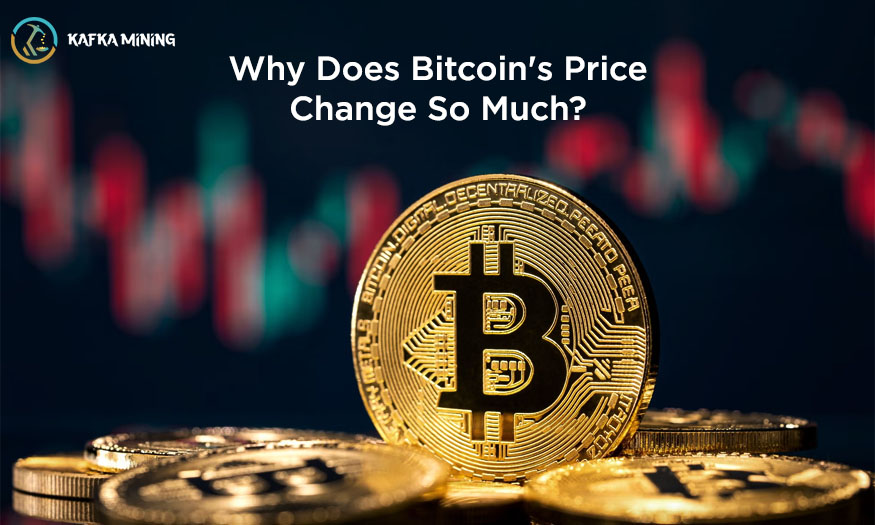
In the ever-evolving world of finance, Bitcoin has emerged as a fascinating and highly talked-about asset. One of the key aspects that often perplexes both seasoned investors and newcomers alike is its volatility. The sharp fluctuations in its price have led many to wonder: why is Bitcoin so volatile? In this blog, we'll delve into the factors behind Bitcoin's volatility, exploring the various elements that contribute to its price swings. By understanding these dynamics, we can gain deeper insights into the unique nature of Bitcoin and its place in the financial landscape.
Volatility refers to the degree of variation in the price of an asset relative to its average price over a specified period. When an asset experiences significant price fluctuations, it is considered volatile.
In the case of Bitcoin, its price has surged by around 50 times over the past five years, indicating substantial volatility compared to more stable assets like bonds or stocks. While high volatility can offer the potential for lucrative returns, it also signifies greater risk. As a result, investing in Bitcoin can be less predictable in the short term than traditional investments.
Bitcoin's volatility stems from various factors inherent in its nature and the dynamics of its market. The currency's relative newness contributes to its susceptibility to fluctuations, as investors continuously adjust their expectations in response to global events. Additionally, the Bitcoin market lacks the efficiency seen in more established markets, making it more vulnerable to sudden shifts in supply and demand. These factors often lead to significant fluctuations in Bitcoin's spot price.
Since its inception in 2009, Bitcoin has undergone a remarkable evolution, transitioning from a niche project to a widely recognized digital asset. Its role in the global economy remains in flux as various stakeholders, including regulators and financial institutions, grapple with its implications. Consequently, sentiments surrounding Bitcoin are subject to constant reevaluation, with its market dynamics often influenced by regulatory decisions and institutional adoption. As the landscape continues to evolve, investor expectations shape Bitcoin's trajectory, reflecting both current developments and prospects.
The speculation surrounding Bitcoin is compounded by its unique nature as an asset. Unlike traditional investments, which derive their value from expected future cash flows such as dividends or bond coupons, Bitcoin's worth hinges solely on its anticipated future value. While traditional assets offer a clearer framework for assessing risk due to their cash flow-based valuation models, Bitcoin's value is intricately tied to its role within the global economy. Consequently, this dynamic leads to a broader spectrum of price forecasts, as every assumption about Bitcoin's utility profoundly influences market expectations.
The volatility of Bitcoin is also influenced by its market dynamics, particularly its relatively small market capitalization compared to other assets like gold. With a market capitalization of around $1 trillion, Bitcoin is significantly smaller than gold, making it susceptible to rapid price movements caused by the actions of individual entities. When a large holder of Bitcoin decides to buy or sell, it can have a disproportionate effect on the market due to the limited depth of the market. This means that even small trades can lead to significant price fluctuations, contributing to Bitcoin's volatility.
The relative novelty and smaller scale of the Bitcoin market pose challenges for investors. Unlike traditional assets such as stocks, Bitcoin lacks a mature ecosystem of financial products and exchanges. While major stock exchanges like the New York Stock Exchange dominate, Bitcoin liquidity is dispersed across numerous exchanges, limiting market depth for large trades. Additionally, the range of derivative products available for Bitcoin is still developing, hindering investors' ability to hedge or leverage their positions effectively. As Bitcoin derivatives evolve and mature, they may help mitigate volatility by offering more sophisticated risk management tools.
Over time, Bitcoin's volatility is expected to decrease due to various factors. As regulations surrounding Bitcoin become clearer globally, its price fluctuations should stabilize. Moreover, as the asset matures and gains wider adoption, the influence of individual holders on market movements is likely to diminish. While large holders may still impact prices, the growing market depth and efficiency will mitigate their effects. Additionally, the development of new investment vehicles and improved market infrastructure will contribute to a more stable trading environment for Bitcoin.
1. Volatility reflects the uncertainty and potential rewards linked to an investment.
2. Bitcoin's volatility stems from factors like market immaturity and speculative trading.
3. As regulatory clarity and market efficiency improve, Bitcoin's volatility is anticipated to decrease.
Leave a Comment